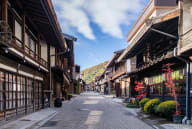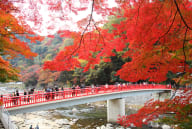
Ibaraki Satisfy your appetite with local treasures
A Culinary Journey in Ibaraki
Ibaraki Prefecture, nestled in the northeast of the Kanto region, is a hidden gem celebrated for its rich agricultural heritage and diverse culinary offerings. With its fertile plains and proximity to the Pacific Ocean, Ibaraki enjoys a temperate climate that supports a wide variety of crops and seafood.
Renowned as the "Kitchen Garden of Tokyo," Ibaraki is famous for its fresh vegetables, including crisp cabbage, juicy watermelons, and sweet melons. The prefecture's fertile soils and abundant sunshine contribute to the exceptional quality and flavour of its produce, which is beloved both locally and nationwide. Ibaraki's coastline provides an abundant catch of seafood, with specialties such as Kashima-gani (crab) and Buri (yellowtail) from the Pacific waters. These delicacies are integral to local cuisine, offering a taste of the region's maritime bounty.
In addition to its renowned agriculture and seafood, Ibaraki is also known for its dedication to traditional craftsmanship, seen in its production of Kasama-yaki pottery and Kashima-nuri lacquerware. Whether indulging in farm-fresh vegetables or savouring the delicacies of the ocean, Ibaraki invites you to celebrate in its natural abundance the long-adored regional staples that have come of it.
Savour each bite and let Ibaraki's culinary treasures leave a lasting impression.
Anko-nabe (Monkfish hot pot)

What it is (ingredients)
Anko-nabe is a beloved hot pot dish from Ibaraki prefecture, showcasing monkfish (Anko) as its star ingredient. This nourishing meal features slices of monkfish meat, which known for its firm texture and delicate flavour. The hot pot is prepared with a flavourful broth made from kombu dashi (seaweed stock), soy sauce, mirin (sweet rice wine), and miso infused with the natural umami of the sea. Seasonal vegetables such as napa cabbage, mushrooms, and tofu complement the dish, offering a nutritious balance to the rich monkfish.
History/Origin
Anko-nabe originated as a dish eaten by fisherman to stay warm on boats, with monkfish initially not valued for sale. Over time, locals refined its taste through trial and error, making it a renowned local dish of Ibaraki that is now enjoyed nationwide. The Oarai Anko Festival in November attracts people from across Japan to celebrate this culinary tradition.
Where You Can Eat
Anko-nabe can be found in seafood restaurants, traditional Japanese inns (Ryokan), and specialty eateries across Ibaraki prefecture, particularly in coastal towns where monkfish is abundant.
When to Eat
Best enjoyed during the colder months, especially in winter when monkfish is at its peak, Anko-nabe offers comforting warmth and robust flavours. It is a dish that brings people together, fostering a sense of community and celebration around its savoury aroma and nourishing broth.
Enjoy the rich flavours of monkfish hotpot, a testament to local wisdom and effort, and savour a nutritious meal that is truly unique.
Mito Natto (Fermented soybeans)

What it is (ingredients)
Mito Natto is a traditional dish from Ibaraki made from fermented soybeans. The soybeans undergo a fermentation process using bacillus subtilis var. natto, which creates a unique texture and pungent aroma. Natto is known for its sticky consistency and strong flavour, often accompanied by mustard and soy sauce. It is commonly served over hot rice as a breakfast staple or as a nutritious side dish. Although Natto has a somewhat polarising reputation overseas, it is a staple among Japanese breakfasts. Although several varieties are enjoyed nationwide, Mito Natto enjoys particular renown.
History/Origin
In Ibaraki, a prefecture which produces over half of Japan's natto, legend has it that natto was discovered when a samurai found fermented beans with sticky strings after opening a bale of rice straw that he had been carrying on horseback. Commercialized during the Meiji period, Mito natto gained nationwide fame for its delicious flavour.
Where You Can Eat
Mito Natto can be found in supermarkets, local markets, and specialty shops throughout Ibaraki prefecture, particularly in Mito City and surrounding areas. It is also a common offering in traditional Japanese breakfasts served at Ryokan (Japanese inns) and minshuku (guesthouses), providing visitors with an authentic taste of local flavour.
When to Eat
Enjoy Mito Natto year-round as a versatile dish that can be incorporated into various meals. Its strong flavour and nutritional benefits make it a popular choice for breakfast or as a quick snack, offering a taste of Ibaraki's culinary tradition with every bite.
While natto may have a distinctive aroma and texture, its high nutritional value makes it worth experiencing. Give Mito Natto a try and savor its refined taste!































































